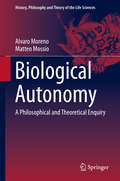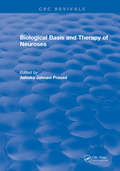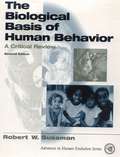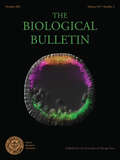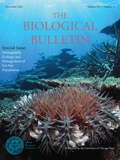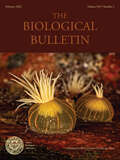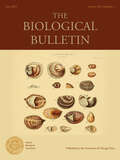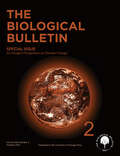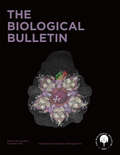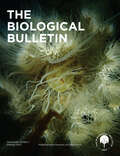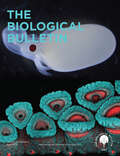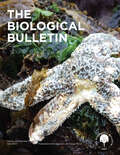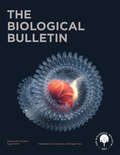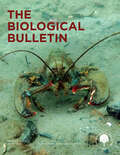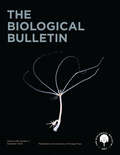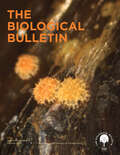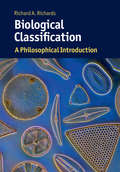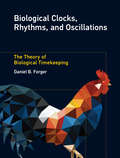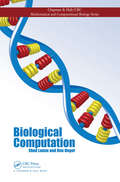- Table View
- List View
Biological Autonomy: A Philosophical and Theoretical Enquiry (History, Philosophy and Theory of the Life Sciences #12)
by Alvaro Moreno Matteo MossioSince Darwin, Biology has been framed on the idea of evolution by natural selection, which has profoundly influenced the scientific and philosophical comprehension of biological phenomena and of our place in Nature. This book argues that contemporary biology should progress towards and revolve around an even more fundamental idea, that of autonomy. Biological autonomy describes living organisms as organised systems, which are able to self-produce and self-maintain as integrated entities, to establish their own goals and norms, and to promote the conditions of their existence through their interactions with the environment. Topics covered in this book include organisation and biological emergence, organisms, agency, levels of autonomy, cognition, and a look at the historical dimension of autonomy. The current development of scientific investigations on autonomous organisation calls for a theoretical and philosophical analysis. This can contribute to the elaboration of an original understanding of life - including human life - on Earth, opening new perspectives and enabling fecund interactions with other existing theories and approaches. This book takes up the challenge.
The Biological Bases of Economic Behaviour: A Concise Introduction
by David McFarlandHuman genetics has changed little over the past 20,000 years, but human economic behaviour has changed a lot. These changes are probably due to human cultural evolution. But studies of human hunter-gatherers, and of a variety of other animal species, show that their micro-economic behaviour is much the same. Whereas the standard economic analysis focuses on money, the biological approach brings time and energy into the analysis. Moreover, humans and other animals tested under laboratory conditions do not exhibit the complexity of the results of field studies. In other words, results obtained in the real world are not the same as those obtained in the laboratory. <P><P> The Biological Bases of Economic Behaviour invites readers to approach micro-economics from a biological viewpoint, in a clear and introductory manner.
Biological Basis and Therapy of Neuroses
by Ashoka PrasadParadoxically, it is the termneurosis more than perhaps any other which has the implication of organic basis. Possibly the popular but erroneous belief that it implies impeded systematic biological research in this area. On scrutiny, it becomes obvious that there is considerable evidence for a biological basis to these hitherto ignored conditions. This book endeavours to present this information in a systematic manner.
The Biological Basis of Human Behavior: A Critical Review (Second Edition)
by Robert W. SussmanThis collection of 59 recent studies on the biological basis of human behavior explores the questions of whether the behavioral patterns we see are genetically fixed or racially variable. It offers a broad perspective from many disciplines -- plus a critical evaluation of whether experts are now better able to answer these questions or whether this renewed interest is just a resurgence of the old racism and biological determinism of the past. The articles stimulate readers to think about the questions and read -- with a critical eye -- those writers who believe they have found a simple and simplistic answer to these very complex problems. Illustrates the growing awareness of the complex interrelationships between environmental and cultural influences on behavior in humans and other animals. Covers areas such as evolution, humans, and primates; the biological basis of human behavior; the biological basis of race and racism; the new Biological Determinism; the brain, hormones, and human behavior. Includes popular, scientific, good and bad approaches to the same themes. Uses critical examples which carefully evaluate alternate approaches, and evaluates the data available to reach various conclusions -- or lack thereof. For anyone interested in the biological basis of human behavior.
The Biological Bulletin, volume 241 number 2 (October 2021)
by The Biological BulletinThis is volume 241 issue 2 of The Biological Bulletin. The Biological Bulletin disseminates novel scientific results in broadly related fields of biology in keeping with more than 100 years of a tradition of excellence. The Bulletin publishes outstanding original research with an overarching goal of explaining how organisms develop, function, and evolve in their natural environments. To that end, the journal publishes papers in the fields of Neurobiology and Behavior, Physiology and Biomechanics, Ecology and Evolution, Development and Reproduction, Cell Biology, Symbiosis and Systematics. The Bulletin emphasizes basic research, including articles on marine model systems and those of an interdisciplinary nature.
The Biological Bulletin, volume 241 number 3 (December 2021)
by The Biological BulletinThis is volume 241 issue 3 of The Biological Bulletin. The Biological Bulletin disseminates novel scientific results in broadly related fields of biology in keeping with more than 100 years of a tradition of excellence. The Bulletin publishes outstanding original research with an overarching goal of explaining how organisms develop, function, and evolve in their natural environments. To that end, the journal publishes papers in the fields of Neurobiology and Behavior, Physiology and Biomechanics, Ecology and Evolution, Development and Reproduction, Cell Biology, Symbiosis and Systematics. The Bulletin emphasizes basic research, including articles on marine model systems and those of an interdisciplinary nature.
The Biological Bulletin, volume 242 number 1 (February 2022)
by The Biological BulletinThis is volume 242 issue 1 of The Biological Bulletin. The Biological Bulletin disseminates novel scientific results in broadly related fields of biology in keeping with more than 100 years of a tradition of excellence. The Bulletin publishes outstanding original research with an overarching goal of explaining how organisms develop, function, and evolve in their natural environments. To that end, the journal publishes papers in the fields of Neurobiology and Behavior, Physiology and Biomechanics, Ecology and Evolution, Development and Reproduction, Cell Biology, Symbiosis and Systematics. The Bulletin emphasizes basic research, including articles on marine model systems and those of an interdisciplinary nature.
The Biological Bulletin, volume 242 number 3 (June 2022)
by The Biological BulletinThis is volume 242 issue 3 of The Biological Bulletin. The Biological Bulletin disseminates novel scientific results in broadly related fields of biology in keeping with more than 100 years of a tradition of excellence. The Bulletin publishes outstanding original research with an overarching goal of explaining how organisms develop, function, and evolve in their natural environments. To that end, the journal publishes papers in the fields of Neurobiology and Behavior, Physiology and Biomechanics, Ecology and Evolution, Development and Reproduction, Cell Biology, Symbiosis and Systematics. The Bulletin emphasizes basic research, including articles on marine model systems and those of an interdisciplinary nature.
The Biological Bulletin, volume 243 number 1 (August 2022)
by The Biological BulletinThis is volume 243 issue 1 of The Biological Bulletin. The Biological Bulletin disseminates novel scientific results in broadly related fields of biology in keeping with more than 100 years of a tradition of excellence. The Bulletin publishes outstanding original research with an overarching goal of explaining how organisms develop, function, and evolve in their natural environments. To that end, the journal publishes papers in the fields of Neurobiology and Behavior, Physiology and Biomechanics, Ecology and Evolution, Development and Reproduction, Cell Biology, Symbiosis and Systematics. The Bulletin emphasizes basic research, including articles on marine model systems and those of an interdisciplinary nature.
The Biological Bulletin, volume 243 number 2 (October 2022)
by The Biological BulletinThis is volume 243 issue 2 of The Biological Bulletin. The Biological Bulletin disseminates novel scientific results in broadly related fields of biology in keeping with more than 100 years of a tradition of excellence. The Bulletin publishes outstanding original research with an overarching goal of explaining how organisms develop, function, and evolve in their natural environments. To that end, the journal publishes papers in the fields of Neurobiology and Behavior, Physiology and Biomechanics, Ecology and Evolution, Development and Reproduction, Cell Biology, Symbiosis and Systematics. The Bulletin emphasizes basic research, including articles on marine model systems and those of an interdisciplinary nature.
The Biological Bulletin, volume 243 number 3 (December 2022)
by The Biological BulletinThis is volume 243 issue 3 of The Biological Bulletin. The Biological Bulletin disseminates novel scientific results in broadly related fields of biology in keeping with more than 100 years of a tradition of excellence. The Bulletin publishes outstanding original research with an overarching goal of explaining how organisms develop, function, and evolve in their natural environments. To that end, the journal publishes papers in the fields of Neurobiology and Behavior, Physiology and Biomechanics, Ecology and Evolution, Development and Reproduction, Cell Biology, Symbiosis and Systematics. The Bulletin emphasizes basic research, including articles on marine model systems and those of an interdisciplinary nature.
The Biological Bulletin, volume 244 number 1 (February 2023)
by The Biological BulletinThis is volume 244 issue 1 of The Biological Bulletin. The Biological Bulletin disseminates novel scientific results in broadly related fields of biology in keeping with more than 100 years of a tradition of excellence. The Bulletin publishes outstanding original research with an overarching goal of explaining how organisms develop, function, and evolve in their natural environments. To that end, the journal publishes papers in the fields of Neurobiology and Behavior, Physiology and Biomechanics, Ecology and Evolution, Development and Reproduction, Cell Biology, Symbiosis and Systematics. The Bulletin emphasizes basic research, including articles on marine model systems and those of an interdisciplinary nature.
The Biological Bulletin, volume 244 number 2 (April 2023)
by The Biological BulletinThis is volume 244 issue 2 of The Biological Bulletin. The Biological Bulletin disseminates novel scientific results in broadly related fields of biology in keeping with more than 100 years of a tradition of excellence. The Bulletin publishes outstanding original research with an overarching goal of explaining how organisms develop, function, and evolve in their natural environments. To that end, the journal publishes papers in the fields of Neurobiology and Behavior, Physiology and Biomechanics, Ecology and Evolution, Development and Reproduction, Cell Biology, Symbiosis and Systematics. The Bulletin emphasizes basic research, including articles on marine model systems and those of an interdisciplinary nature.
The Biological Bulletin, volume 244 number 3 (June 2023)
by The Biological BulletinThis is volume 244 issue 3 of The Biological Bulletin. The Biological Bulletin disseminates novel scientific results in broadly related fields of biology in keeping with more than 100 years of a tradition of excellence. The Bulletin publishes outstanding original research with an overarching goal of explaining how organisms develop, function, and evolve in their natural environments. To that end, the journal publishes papers in the fields of Neurobiology and Behavior, Physiology and Biomechanics, Ecology and Evolution, Development and Reproduction, Cell Biology, Symbiosis and Systematics. The Bulletin emphasizes basic research, including articles on marine model systems and those of an interdisciplinary nature.
The Biological Bulletin, volume 245 number 1 (August 2023)
by The Biological BulletinThis is volume 245 issue 1 of The Biological Bulletin. The Biological Bulletin disseminates novel scientific results in broadly related fields of biology in keeping with more than 100 years of a tradition of excellence. The Bulletin publishes outstanding original research with an overarching goal of explaining how organisms develop, function, and evolve in their natural environments. To that end, the journal publishes papers in the fields of Neurobiology and Behavior, Physiology and Biomechanics, Ecology and Evolution, Development and Reproduction, Cell Biology, Symbiosis and Systematics. The Bulletin emphasizes basic research, including articles on marine model systems and those of an interdisciplinary nature.
The Biological Bulletin, volume 245 number 2 (October 2023)
by The Biological BulletinThis is volume 245 issue 2 of The Biological Bulletin. The Biological Bulletin disseminates novel scientific results in broadly related fields of biology in keeping with more than 100 years of a tradition of excellence. The Bulletin publishes outstanding original research with an overarching goal of explaining how organisms develop, function, and evolve in their natural environments. To that end, the journal publishes papers in the fields of Neurobiology and Behavior, Physiology and Biomechanics, Ecology and Evolution, Development and Reproduction, Cell Biology, Symbiosis and Systematics. The Bulletin emphasizes basic research, including articles on marine model systems and those of an interdisciplinary nature.
The Biological Bulletin, volume 245 number 3 (December 2023)
by The Biological BulletinThis is volume 245 issue 3 of The Biological Bulletin. The Biological Bulletin disseminates novel scientific results in broadly related fields of biology in keeping with more than 100 years of a tradition of excellence. The Bulletin publishes outstanding original research with an overarching goal of explaining how organisms develop, function, and evolve in their natural environments. To that end, the journal publishes papers in the fields of Neurobiology and Behavior, Physiology and Biomechanics, Ecology and Evolution, Development and Reproduction, Cell Biology, Symbiosis and Systematics. The Bulletin emphasizes basic research, including articles on marine model systems and those of an interdisciplinary nature.
The Biological Bulletin, volume 246 number 1 (February 2024)
by The Biological BulletinThis is volume 246 issue 1 of The Biological Bulletin. The Biological Bulletin disseminates novel scientific results in broadly related fields of biology in keeping with more than 100 years of a tradition of excellence. The Bulletin publishes outstanding original research with an overarching goal of explaining how organisms develop, function, and evolve in their natural environments. To that end, the journal publishes papers in the fields of Neurobiology and Behavior, Physiology and Biomechanics, Ecology and Evolution, Development and Reproduction, Cell Biology, Symbiosis and Systematics. The Bulletin emphasizes basic research, including articles on marine model systems and those of an interdisciplinary nature.
Biological Centrifugation
by Dr John GrahamAn important introduction to the use of the centrifuge in the biology laboratory, Biological Centrifugation is also useful for more experienced workers. The book describes the background and the principles behind centrifugation, including sedimentation theory. The book also considers the different types of centrifuge and other centrifuge hardware available, density gradient media and gradient technology. Although aimed primarily at the novice, this title also provides information to allow more experienced workers to modify and update existing techniques.
Biological Chemistry of Arsenic, Antimony and Bismuth
by Hongzhe SunArsenic, antimony and bismuth, three related elements of group 15, are all found in trace quantities in nature and have interesting biological properties and uses. While arsenic is most well known as a poison - and indeed the contamination of groundwater by arsenic is becoming a major health problem in Asia - it also has uses for the treatment of blood cancer and has long been used in traditional chinese medicine. Antimony and bismuth compounds are used in the clinic for the treatment of parasitic and bacterial infections.Biological Chemistry of Arsenic, Antimony and Bismuth is an essential overview of the biological chemistry of these three elements, with contributions from an international panel of experts. Topics covered include:chemistry of As, Sb and Bibiological chemistry of arsenicbiological chemistry of Sb and Biarsenic and antimony speciation in environmental and biological samplesarsenic in traditional chinese medicinearsenic in aquifersbiomethylation of As, Sb and Biuptake of metalloids by cellsbismuth complexes of porphyrins and their potential in medical applicationsHelicobacter pylori and bismuthmetabolism of arsenic trioxide in blood of the acute promyelocytic leukemia patientsanticancer properties of As, Sb and Biradio-Bi in cancer therapygenotoxicity of As, Sb and Bimetallomics as a new technique for As, Sb and Bimetalloproteomics for As, Sb and BiBiological Chemistry of Arsenic, Antimony and Bismuth conveys the essential aspects of the bioinorganic chemistry of these three elements, making this book a valuable complement to more general bioinorganic chemistry texts and more specialized topical reviews. It will find a place on the bookshelves of practitioners, researchers and students working in bioinorganic chemistry and medicinal chemistry.
Biological Classification: A Philosophical Introduction (Cambridge Introductions to Philosophy and Biology)
by Richard A. RichardsModern biological classification is based on the system developed by Linnaeus, and interpreted by Darwin as representing the tree of life.But despite its widespread acceptance, the evolutionary interpretation has some problems and limitations. <P><P> This comprehensive book provides a single resource for understanding all the main philosophical issues and controversies about biological classification. It surveys the history of biological classification from Aristotle to contemporary phylogenetics and shows how modern biological classification has developed and changed over time. Readers will also be able to see how biological classification is in part a consequence of human psychology, language development and culture. <P>The book will be valuable for student readers and others interested in a range of topics in philosophy and biology.<P> Comprehensive, covering all the main philosophical issues in biological classification<P> Includes a survey of the history of biological classification from Aristotle to the present<P> Naturalistic, in the sense that it begins with what the sciences tell us about the cultural, psychological and linguistic foundations of biological classification
Biological Clocks
by Susan BinkleyBiological Clocks introduces the subject of human chronobiology. It describes biological clocks; why we have clocks; how biological clocks relate to sleep disorders, depression, and jet lag; and how the reader can measure his/her own rhythms.
Biological Clocks, Rhythms, and Oscillations: The Theory of Biological Timekeeping (The\mit Press Ser.)
by Daniel B. ForgerAn introduction to the mathematical, computational, and analytical techniques used for modeling biological rhythms, presenting tools from many disciplines and example applications.All areas of biology and medicine contain rhythms, and these behaviors are best understood through mathematical tools and techniques. This book offers a survey of mathematical, computational, and analytical techniques used for modeling biological rhythms, gathering these methods for the first time in one volume. Drawing on material from such disciplines as mathematical biology, nonlinear dynamics, physics, statistics, and engineering, it presents practical advice and techniques for studying biological rhythms, with a common language. The chapters proceed with increasing mathematical abstraction. Part I, on models, highlights the implicit assumptions and common pitfalls of modeling, and is accessible to readers with basic knowledge of differential equations and linear algebra. Part II, on behaviors, focuses on simpler models, describing common properties of biological rhythms that range from the firing properties of squid giant axon to human circadian rhythms. Part III, on mathematical techniques, guides readers who have specific models or goals in mind. Sections on “frontiers” present the latest research; “theory” sections present interesting mathematical results using more accessible approaches than can be found elsewhere. Each chapter offers exercises. Commented MATLAB code is provided to help readers get practical experience. The book, by an expert in the field, can be used as a textbook for undergraduate courses in mathematical biology or graduate courses in modeling biological rhythms and as a reference for researchers.
Biological Computation (Chapman & Hall/CRC Computational Biology Series)
by Ehud Lamm Ron UngerThe area of biologically inspired computing, or biological computation, involves the development of new, biologically based techniques for solving difficult computational problems. A unified overview of computer science ideas inspired by biology, Biological Computation presents the most fundamental and significant concepts in this area. In the book
Biological Concepts and Techniques in Toxicology: An Integrated Approach
by Jim E. RiviereHighlighting the latest advances in molecular biology, mathematical modeling, quantitative risk assessment, and biopharmaceutical development, this reference presents how current scientific applications and methods impact and revolutionize mainstream toxicological research. Presenting findings from disciplines that will impact the future of toxicol
